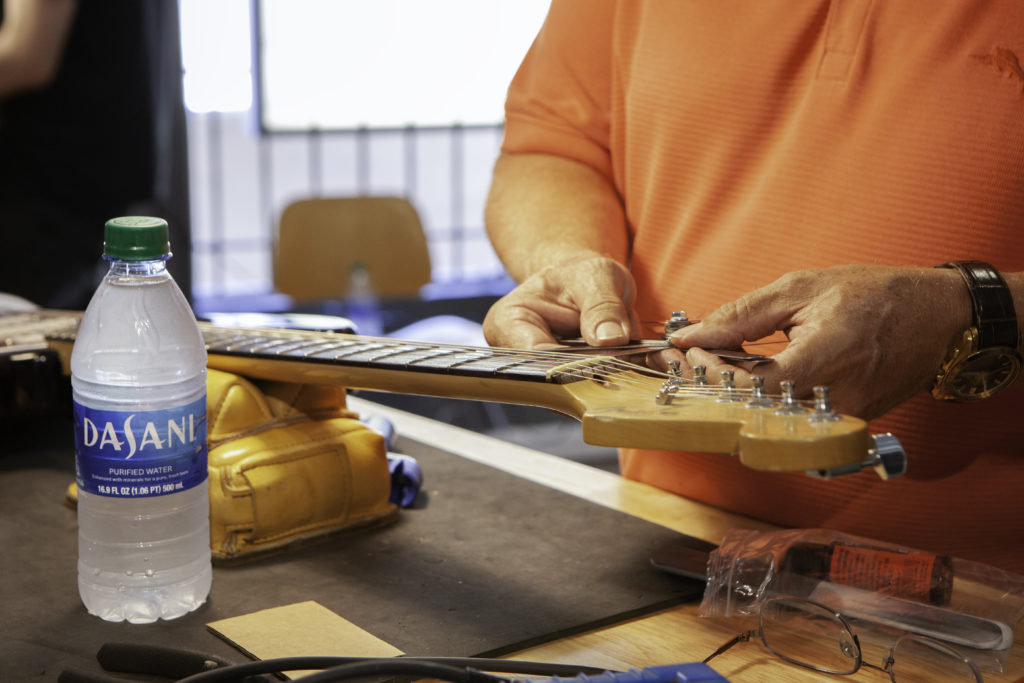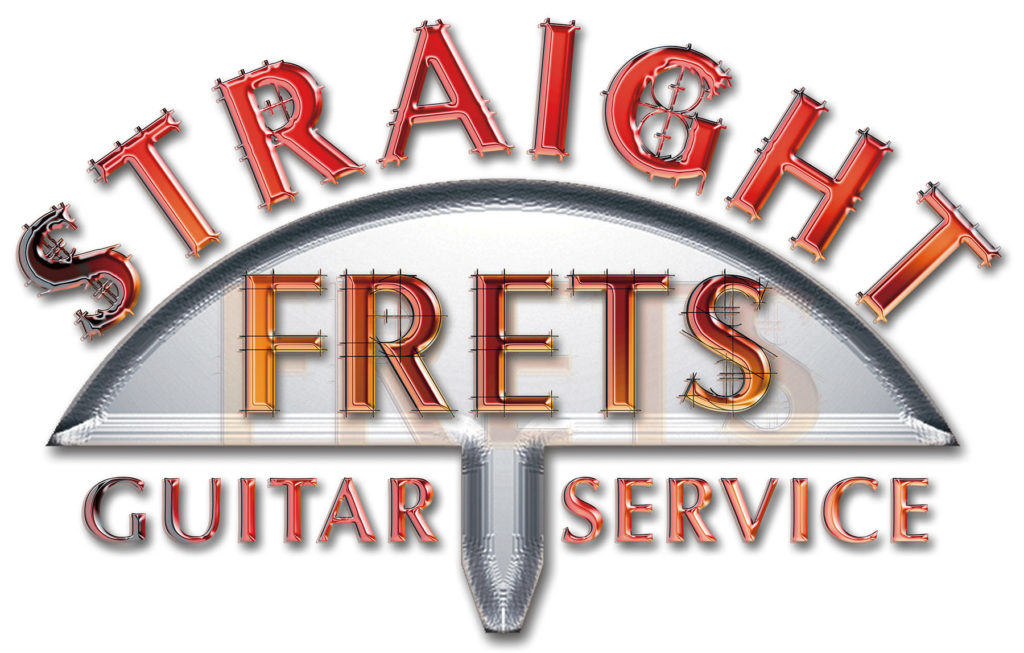General Repair Services

Basic Setup
For gigging musicians on the go
Our basic setup includes cleaning and conditioning the fingerboard, polishing the frets to a glossy shine, cleaning the body and back of the neck/head, tightening loose screws and tuners, restringing, adjusting the truss rod, setting the action at the nut slots and bridge, and setting the intonation with a Peterson strobe tuner. The focus here is to make the guitar look, play, and sound new again. Any replacement parts, electronic work, or other fretwork is extra.
Deluxe Setup
More intensive work with longer wait times
The deluxe setup takes the basic setup to a higher cosmetic level by removing pickups and hardware, buffing out the finish to a new luster, polishing out rusty screw heads, and removing the tuners to buff the headstock. Extreme cases can cost more than the $50 up charge. Time can be taken to remove tuners and other hardware, polish them separately, level the finish with 500, 1000, 1500, and then 2000 grit wet and dry paper, then buff the finish to a like-new luster. High speed cotton wheel buffers are utilized to bring out the original shine and luster of faded nitrocellulose, French polished, and lacquer finishes. Menzerna polishing compounds (as used by Fender and Gibson Custom Shops) achieve consistent results with electric and acoustic guitars alike. All of this reflects my years of detailing cars as a teenager in addition to appreciating a well-maintained instrument.
Nuts & Saddles
Bone is Straight Fret’s preferred material for nut and saddle repairs. It has some of the most magical acoustical properties of any material we’ve found. The final shape is cut from blanks to fit your instrument with tolerances up to one thousandth of an inch, and we age it to an antique white color on most guitars.
Acoustic Guitar Pickup Installs
I prefer to install the K & K Ultra Pure Mini system into both nylon and steel string guitars. These retail for $180, and we charge $120 to install them. They utilize a control base that borders the top inner rim of the sound hole, essentially being invisible when being played and eliminating the need for a huge hole to be cut into the side. The installation requires an input jack to be installed in the butt of the guitar, transducers gel super glued to the bridge plate directly under the saddle, a 9-volt battery pack (Velcro canvas pouch) to be stuck to the heel of the guitar, and the aforementioned control base to be mounted to the rim of the sound hole. If the latter requires a custom shim made to create a level mounting surface, $25 is added to the cost of the installation.
Refrets
We carefully remove the frets after heating them slightly. The Plek resurfaces the board with a diamond downcut bit, safe for all inlays. It takes as little wood as possible off of the board when prepping it for frets. I clean the slot thoroughly with specialty tools and a vacuum. I then measure the depth and width of each slot to insure a proper fit of the new frets. Client’s fret choice needs to be made here at the shop if possible. I have a sample 21-fret neck with different sized wire every three frets. Frets are then over radiused to insure proper grip of the tang on the walls of the slot. Frets are glued in with gel CA while either being hammered or pressed into the neck. Frets are then leveled with string pressure factored in with the Plek, then the slots are cut into a bone blank. The fret ends are gently rounded, and each fret is then polished in four stages to a chrome-like luster. The fingerboard is cleaned and conditioned with oil, then action, radius, and intonation is adjusted with a Peterson strobe tuner.
Leveling, Recrowning, and Dressing Frets
Given that there is enough meat to the fret and that the board has the proper shape to it, frets can be leveled and recrowned (rounded) a few times before a refret is needed. This process involves having the Plek machine measure the fingerboard and the fret tops with a robotic finger accurate to 2/10,000″. The machine can dress the frets with the proper neck relief in mind for each string. From there, the frets are buffed shiny smooth, the board cleaned & oiled, and nut slots, action, and intonation are adjusted to your preference to give your instrument the highest level of care it can receive.
Electronic Work
All wiring is done with the highest quality CTS pots with tolerances of less than 10%. We also use braided cloth wiring, Switchcraft jacks, and quality solder. Any of the potentiometer, switch, or pickup replacement costs reflect a direct fit replacement. Any special modifications to the guitar or pickups are discussed prior to any operation. We never assume an agreement. The SwitchCraft jacks and Callaham blender pots we use are cryogenically treated. This process takes steel and holds it at a temperature of -500 degrees Fahrenheit for a 24 hour period, then allows the metal to rise back to room temperature over another 24 hours. This modifies the molecular structure of metal to a more uniform grain alignment, increasing its strength, hardness, and acoustical qualities. Used by NASA, NASCAR, on US military circuit boards, and of course, at Straight Frets electronics department. Please call or email us with any electronics questions you might have. When multiple electronics jobs are combined, the bill reflects a 10% reduction of labor costs.
Bridge Reglues
Shell Dot Inlays
A common addition to handmade concert classical guitars, shell dots help dress up the edge of a fretboard much nicer than white-out or a piece of tape. Brad point bits are used to precisely drill the holes without chipping any surrounding finish. Once glued in, Straight Frets diamond leveling files (as sold in the eBay store) are used to file the tops of the shell uniformly into the existing finish, which is then buffed to a uniform gloss. The end result are dots that look as if they were installed before the neck was finished. Dots are carefully selected for uniform color, and placed to shine from the player’s perspective at the 5th and 7th frets, or with the addition of the 9th fret.
Carbon Fiber & Bone Shims
Carbon fiber shims are quite possibly the best thing since sliced bread. It comes in three thicknesses: .010”, .020”, .030”, the latter being the thickness of a credit card. We glue these on to the bottom of nuts or saddles, but can also custom cut them for you unglued if you’d like to experiment with stacking them. On occasion we have to glue two pieces together, which of course doubles the cost. On older Martin and Gibson acoustics, especially those with adjustable height screws on the sides, we strongly suggest a chuck of carbon to fill that void between the saddle and the soundboard. You won’t believe your ears! Bone shims come in .020” thickness and are a great alternative to carbon at the nut if your guitar has a lighter colored neck. It can also be used for saddle shimming and like the carbon, can be left unglued for you to experiment with different heights and strings.
Additional Luthier Services
Other services include:
- Regluing loose binding
- Cleating cracks from continuing
- Partial refrets that match fret ends
- Addressing creaking classical machine heads
- Adding a Bigsby to a solid or semi-hollow guitar
- Resurfacing dented necks and refinish with Tung oil
- Adjusting angles in neck pockets with solid maple shims
- Custom fabrication of bridges, pickguards, and truss covers
- Repairing dents in back of neck with super glue, level, and buff
- Filling old tuner holes and matching color while replacing the tuners
